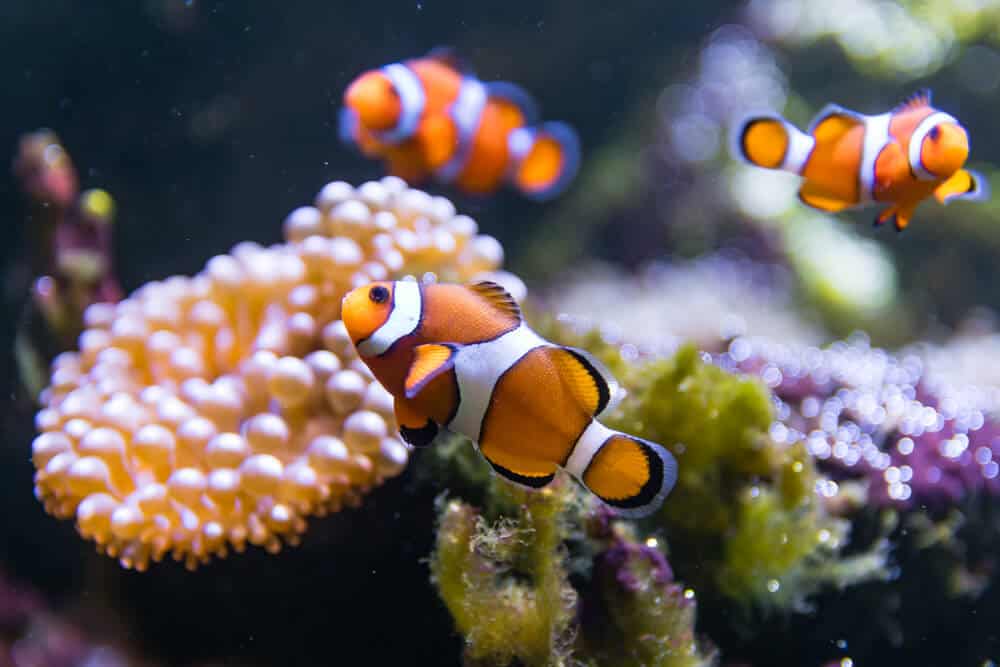
What is a Snowflake Clownfish?
The Snowflake Clownfish is a variation of the Ocellaris Clownfish species. They are known for their irregular white stripes and markings, which give them their distinct appearance. Unlike other clownfish, Snowflake Clownfish have white coloration instead of the typical orange. The pattern is very different from the normal clownfish, making them a sought-after specimen for many hobbyists.
Snowflake Ocellaris Facts
What is the average lifespan of Snowflake Clownfish?
The lifespan of Snowflake Clownfish varies depending on the care provided. In a well-maintained saltwater aquarium, these fish can live for up to 10 years. With proper nutrition, a suitable environment, and regular health checks, you can help ensure that your Snowflake Clownfish live a long and healthy life.
How big do Snowflake Clownfish get?
Snowflake Clownfish typically reach a size of 3 to 4 inches when fully grown. However, some individuals may grow slightly larger. It is important to consider the adult size of the fish when selecting an appropriate tank size.
What is the Snowflake clownfish price?
The price of Snowflake clownfish can vary depending on several factors. On average, they can cost anywhere from $30 to $100, but prices can even reach up to $200 or more for rare and highly sought-after variations. It is important to note that the cost of the fish is not the only consideration when purchasing them. Other factors that can affect the price include the fish’s size, health, specific coloration, and provenance. Additionally, where you buy the fish from can also impact the price. Local fish stores may have more competitive prices compared to specialized online retailers or breeders.
Snowflake Clownfish Care
Tank Size
When housing a Snowflake Clownfish, the minimum tank size should be at least 13,5 gallons. Nevertheless, I recommend a 20 gallon tank. This will provide enough space for the fish to swim and explore. However, if you plan to keep multiple or want to include other tank mates, a larger tank is recommended to accommodate their needs.
Water Parameters
Creating the right water conditions is crucial for the well-being of your Snowflake Clownfish. The recommended water temperature for these fish is between 75 and 82 degrees Fahrenheit (24 to 28 degrees Celsius). The pH level should be kept between 8.1 to 8.4, and the salinity levels should be maintained at a specific gravity of 1.020 to 1.025.
Setting Up The Aquarium
When setting up the aquarium for Snowflake Clownfish, it is important to replicate their natural habitat as closely as possible. These fish are commonly found in reef environments, so incorporating live rock and a suitable substrate will help create a conducive environment. Ensure that the tank has proper filtration and lighting to support the aquatic life.


What anemone is best for Snowflake clownfish?
The bubble tip anemone (Entacmaea quadricolor) is a popular choice as a host for clownfish. These anemones have colorful tentacles with bulbous tips, resembling bubbles. They can create a stunning visual appearance in the aquarium.
A few reasons why adding this anemone is recommended:
- Symbiotic Relationship: Clownfish and anemones have a mutualistic relationship, meaning they both benefit from each other. Clownfish provide food scraps and protection to them, while they provide shelter and protection to the clownfish.
- Natural Behavior: Clownfish have evolved to live among anemones and seek out their preferred species as hosts. Having an anemone in the aquarium allows the clownfish to exhibit their natural behavior, such as swimming among the tentacles and forming their territories.
- Aesthetics: They are known for their vibrant colors, which can add a pop of visual interest to your aquarium. They come in various shades of green, pink, red, and purple, allowing you to choose the one that suits your aesthetic preferences.
Are Snowflake Clownfish hardy?
Snowflake Clownfish are generally hardy and can withstand common diseases. However, like any fish, they are susceptible to certain ailments if their care requirements are not met. It is important to monitor the water quality regularly and ensure that the tank is free from any parasites or infections. Common diseases include marine ICH and bacterial infections.
What is a good diet for Clownfish?
Snowflake Clownfish are omnivorous and accept a wide variety of foods. Their diet should consist of a balanced mix of commercial pellets, frozen foods, and live foods. Some popular food options include brine shrimp, mysis shrimp, and high-quality marine flakes. Regular feeding, typically twice a day, will ensure that your clownfish receive the necessary nutrients to thrive.
Are Snowflake Clownfish aggressive?
Snowflake Clownfish are known for their peaceful temperament, making them suitable for community tanks. They are generally not aggressive towards other fish species, but they can be territorial towards their own kind. It is recommended to keep them in pairs or small groups to minimize aggression within the tank. Providing plenty of hiding spots and creating a well-structured aquarium setup can also help reduce any potential conflicts.
What fish can live with a Snowflake clownfish?
When selecting tank mates for Snowflake Clownfish, it is important to choose species that are compatible with their peaceful nature. Some suitable tank mates include other clownfish species like the Percula Clownfish, damselfish, gobies, blennies, small wrasses, and certain shrimp and snail species and other peaceful reef fish.
Avoid housing them with aggressive or predatory fish species like the large angelfish, triggers, or groupers.
Breeding Snowflake Clownfish
Breeding Snowflake Clownfish in captivity is a rewarding experience for many aquarists. These fish are known to breed readily in a well-maintained aquarium environment. The male clownfish will take on the role of caring for the eggs, while the female lays them on a flat surface near the anemone. Once the eggs hatch, the fry can be fed a diet of rotifers and newly hatched brine shrimp until they are large enough to consume other foods.







